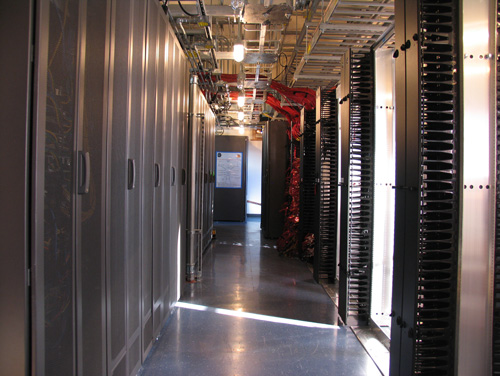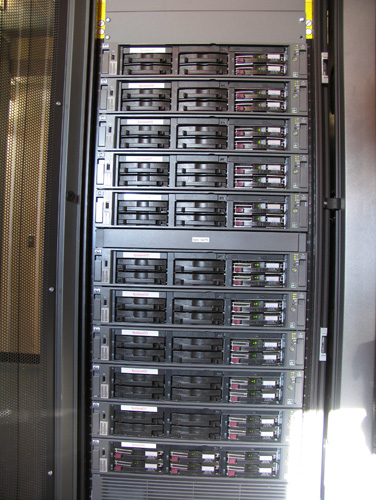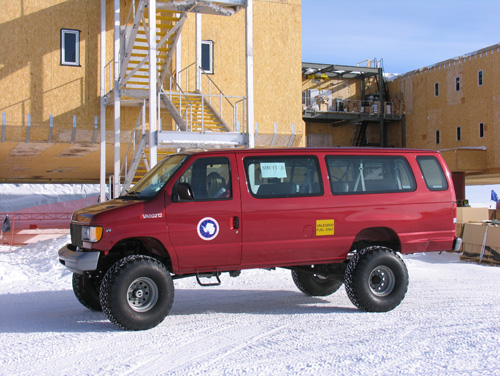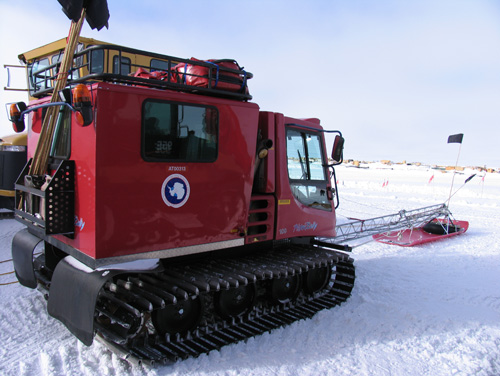Week 4 November 26 - December 3 2007 Bit of Everything about South Pole
The past week was a very busy one, but not very interesting in terms of something to write about. We received our large shipment of IT equipment and spent a few days unpacking it into our receiving area on the first floor of the ICL, and then moving it up to the second floor Data Center. We had a quite a few UPS (Uninterruptible Power Supplies) come in, and these are just big battery systems, and very heavy. It was a few very tiring days. Now I just have to cable everything in!

Me working at the back of a computer rack. We wear ant-static lab coats to avoid Electro-Static Discharge damage to equipment.

It is difficult to take pictures of the computers in the Data Center because there is so little room. We have 18 47U computer racks which are presently about 80%, and will be completely full by the time IceCube is completely built. There are also 10 patch racks which connect the cables that go outside to the cables that go to the back of computers.

This is what the front of a typical server rack. These are 2U quad Opteron servers (HP DL385) which are very suited to the environmental conditions at Pole. They have redundant power, cooling, memory, and hard drives, which all can be replaced live.

This is the rear view of the same server rack. With redundant power supplies, network cables, and KVM, there are is usually 6 cables to each server. With this cable arm configuration we can easily pull a host out from the rack and work on it to replace redundant components, such as cooling fans, without ever shutting down.
The bottom line is that I can't think of anything to write about with any coherent thread through it. I did get a heap of questions from schools, and maybe I'll just use random questions to get my weekly email out.
My favorite question came from a very astute student. "Do you ever get sick of seeing the same people, doing the same thing, being in the same place day after day?". My initial answer was "yes". Most days this is fine. But I think everyone has days when they could do with a change. I (and I think many others do the same) usually just spend a bit of time by myself. But the real trick is to enjoy doing the same thing every day, seeing the same people, and being in the same place. For doing the same thing this is where the work discipline is important. With less people sitting around making sure you get your work done, it would be easy to just not do your work. But this would be the first reason to not get invited back.
I got asked how we get around. It sort of struck me as an odd question at first as we go almost no where. It's not like we commute to work. The furthest away from station I'll get during the 5 week trip is 2 miles. But then again it is a distance from the main station to the Dark Sector. It takes me between 15 and 20 minutes to walk to the ICL. I could waste more than an hour a day walking - well maybe not a complete waste. So we do have vehicles, quite an array of tracked over snow vehicles. The most common is snow mobiles. These are great for getting a couple of people and small amount of equipment around with a sled. But in the past hey weren't as flexible as we would like. A few years ago IceCube had some people moving, and cargo sleds made. Now we can move 8 people around with a snow mobile.

Lunch time snow mobile fleet at DZ (the nick name for the back entrance to the station).
During the summer when it gets hectic, moving people around becomes important. Many science groups only get a couple of weeks at Pole and don't want to spend 10% of it walking around getting tired. Thus when the temperature is high enough (above -35) there is a shuttle service. This is a standard Ford shuttle van with balloon tires. In McMurdo the taxi services is big business, with people constantly going out the runways, or around town.

South Pole shuttle service
However the shuttle can only drive on very well packed snow. The IceCube drill camp is usually surrounded by fairly churned up snow. This is when tracks are needed. At Pole there are a couple of specialty over snow vehicles, the latest being Piston Bullies, best known as snow grooming machines at ski resorts. There are none at Pole, but another common Antarctic tracked vehicle is the Hagglund. These are common at the Australian bases.

Piston Bully.
Surprisingly the commercial grade Fords are almost more reliable than the Piston Bullies. Luckily there is a track conversion system which works well on them. IceCube has a shuttle van and there is a few trucks around town with Mattrack conversions, where the wheels are replaced by miniature track systems. The main fire fighting truck is one of these.

IceCube van with Mattrack conversion.
I got asked about how I dress for these temperatures, which are almost unimaginable for children from a beach suburb of Sydney. Anyone from cold climate will guess that dressing in layers is important. Then I bet most people would guess that everything is high tech. It isn't. After being warm the next most important thing is durability. After all we're here to work and you don't want some light weight down jacket getting caught and ripping. Most of the gear is standard cold weather work gear. One of the big US manufacturers of this type of gear is Carhart, and this is probably the most commonly worn shell at Pole. In the warmer months I wear a Carhart jacket with my insulated bibs, which I wear all weather.
For me 3 layers has always been sufficient here. First layer is thermals longs, and a shirt - usually just a T shirt unless I'm going to need to wick sweat away in which case I'd wear a thermal top. Second layer is what I vary for the temperature. When it's colder I have a fleece top, and when it's warmer I might skip this layer for the top. But I always wear heavy canvas or light wool pants (these are my gardening pants back home). The outer layer is the Carharts, or if it is cold, like the first couple of weeks I was here this year, I'll wear my red jacket. The red jacket is a fairly specialized piece of equipment made by a company called Canada Goose. It is a down jacket with a very heavy duty outer shell, but it still doesn't compress the down. Don't know how they do it, but they are very warm. You can buy your own for a few hundred dollars. Not sure where you'd ever wear it.
There are a number of choices for boots these days. I've generally stuck with the heavy big blue FDX boots. Again I only wear these in the colder months, or if I'm going to be standing around outside. Otherwise I have my leather mountaineering boots which are much less cumbersome. I'm not sure if they issue bunny boots any more - the little rubber thermoses for the feet. There is a new black boot that weighs less than the FDX, but looks very warm.
Everyone has a personal system for the head. As the saying goes, got cold feet, put on a hat. The head is where a lot of heat is lost from the body. One of the problems is stopping goggles or sunglasses from fogging. The most extreme solution I've seen for this is a snorkel. Thought there are a number of other home made contraptions that make the wearer look like Darth Vader.
Finally there is the hands to deal with. The problem is that you occasionally might want to do something with your hands and gloves and mitts make this difficult. After awhile you get very good at working with heavy gloves on. But sometimes you just have to take them off. Some people swear by light weight liners. I don't like this system as it is more difficult to warm finger back up by curling them into the palm of your hand inside your gloves if they have liners on. I have an old camera that is just impossible to operate with gloves on. I can take a roll of film before it reaches the point where I have to take care of my fingers, which is well after having lost feeling in them. But this is fairly common here and you learn to know when you reach the safe limit. I think I'm fairly cold tolerant, but I know people with unimaginable cold endurance who can through tricks and their special physiology endure cold with no harm that would be severe frost bite for people with no experience in these conditions. I should mention that I have my personal favorite gloves which I wear down to about -50. At that point I have some great mitts which I've worn outside for hours at below -100 and my hands have stayed warm, but while walking briskly.
Me in my Extreme Cold Weather (ECW) Gear
This brings us to the question about frost bite. Frost bite which results in permanent damage is extremely rare here. Frost nip is very common. Frost nip is a cold injury which results in maybe a small blister, maybe some inflammation, and surface skin loss. It is a bit scary to see a finger turn white and it is easy to get inside here and warm up before deep tissue freezing occurs. The danger is in the fact that you have gloves on and won't see that white finger. Chances are it's been numb for awhile. The trick is knowing the feelings such as getting difficult to bend, hand getting cold, or what ever is the sign for you to get those fingers warm. I've frozen my nose, cheeks, ears, and fingers quite a few times, but with nothing more than minor inconvenience. I find it less painful than sun burn.
Being in Antarctica I am asked about animals all the time. Luckily I've worked on the coast and can go on endlessly about animals. But many people who come to the South Pole will never see a penguin, which are even fairly rare at McMurdo. Skua gulls and Weddell seals at a distance is the most common animals people will see on their way to Pole. South Pole is just much too far from the coast, and much too cold for any animals. There are very rare sightings of Skua gulls at Pole which must be due to the poor birds getting disoriented over the featureless plateau. They must see the Pole from a long distance out and come to it. I've never seen one, but have been told by people that have that they usually look very weak and near the end.
My favorite penguin page - the Adelie penguin life-cycle.
I assume the kids talked about going to Antarctica and what the hardships might be because I got a number of questions along the lines of "do you ever want to come home to your family and friends?". This comes back to one of the earlier emails about why do people come to Antarctica, and why do they keep coming back. This got me wondering why people spend massive amounts of money to spend a few hours at the Pole. I would have no interest in flying here for a few hours (yes that is easy for some one who has spent over 2 years here to say). But even these short 1 month trips don't give me the time to do one of the things I enjoy most, and that is slowly watching Antarctica, being able to relax and take my time. No rush, I have all the time in the world. Suddenly a winter doesn't seem so long when that is what you want to do. The things you see and experience in Antarctica if you have the time to just sit and wait are amazing. At the South Pole you'll see one of the wonders of the world, a single day and night in a year, and to watch the same stars circle endlessly above you, with the Southern Cross high in the sky. It just takes one year of your life to see this. Yes I have always missed my family and friends while I've been in Antarctica. Life is full of compromises, and this has been the price I've paid. Many times I've wanted to come home, but I just try and remind myself this is what I signed up for. These days I miss my family too much and I just can't wait to get home. I can remember what those stars looked like.
To be continued.

